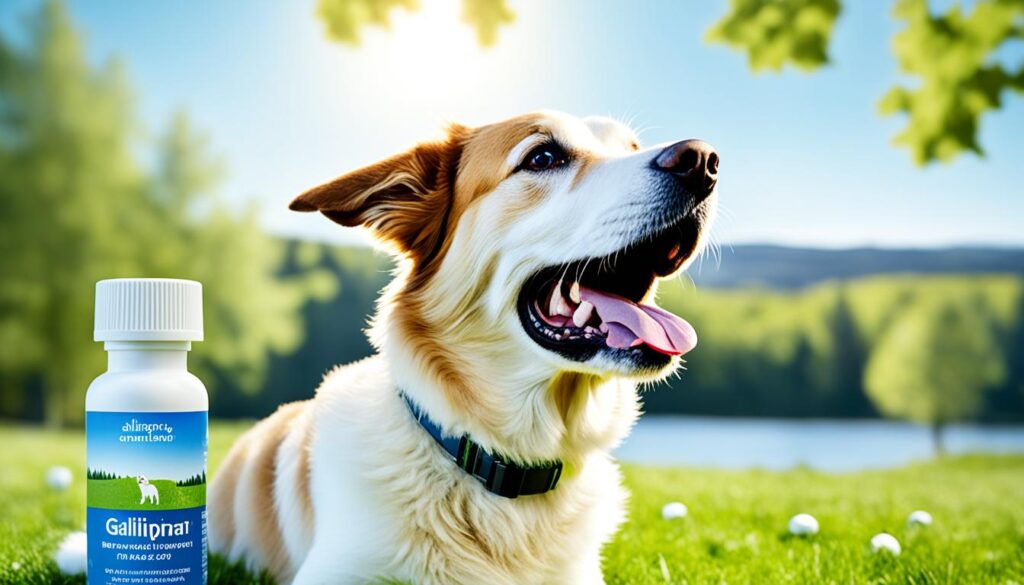As an Amazon Associate I earn from qualifying purchases.
Imagine this: you’re taking a peaceful walk in the park with your furry best friend. The sun is shining, the birds are chirping, and everything seems perfect. But suddenly, you notice something off. Your dog starts to limp, their tail droops, and that spark of joy in their eyes fades away. It’s heart-wrenching to witness your loyal companion suffering from the pain of osteoarthritis.
But don’t lose hope! There is a solution that can bring back the twinkle in your pup’s eyes and put a bounce in their step again. Introducing Galliprant for dogs, a revolutionary medication that provides targeted relief for canine joint pain and inflammation. It’s like a superhero cape for your dog, wiping away their discomfort and allowing them to live their best, pain-free life.
As a dog owner, you want nothing but the best for your furry friend. You’ve tried various treatments, but finding the right one can feel like searching for a needle in a haystack. That’s why Galliprant is a game-changer. It’s specifically designed to address the unique needs of dogs with osteoarthritis, providing exceptional pain relief without the worrying side effects of other medications.
So, if you’re tired of seeing your pup struggle, if you long to see them wag their tail with joy, and if you want to be the hero that eases their pain, Galliprant is the answer you’ve been waiting for.
Key Takeaways:
- Galliprant for dogs is a targeted medication that provides relief for joint pain and inflammation in dogs with osteoarthritis.
- Unlike traditional NSAIDs, Galliprant specifically targets the enzyme involved in the inflammatory process, reducing pain and inflammation without compromising your dog’s well-being.
- Galliprant is primarily used to manage pain and improve the quality of life for dogs with osteoarthritis.
- While Galliprant is generally safe, it’s important to be aware of potential side effects and consult with your veterinarian if you have any concerns.
- Dosage, administration, and duration of treatment should be discussed with your veterinarian to ensure effective and appropriate management of your dog’s condition.
What Is Galliprant?
Galliprant, also known by its generic name grapiprant, is a non-steroidal anti-inflammatory drug (NSAID) used in dogs to manage the pain and inflammation associated with osteoarthritis.
Unlike traditional NSAIDs, Galliprant targets a specific enzyme called prostaglandin E2 (PGE2), which is involved in the inflammatory process. By blocking this enzyme, Galliprant reduces pain and inflammation, providing relief for dogs with osteoarthritis.
“Galliprant specifically targets the enzyme involved in the inflammatory process. It’s like a superhero fighting the villains of pain and inflammation!”
How Does Galliprant Work?
Galliprant’s mechanism of action sets it apart from other NSAIDs. It specifically inhibits the EP4 receptor, which helps regulate pain and inflammation. By selectively targeting this receptor, Galliprant effectively reduces pain and inflammation associated with osteoarthritis, enabling dogs to move more comfortably and enjoy a better quality of life.
The Benefits of Galliprant
Galliprant offers several advantages as a treatment option for dogs with osteoarthritis:
- Targeted Relief: By specifically targeting the EP4 receptor, Galliprant provides focused relief from pain and inflammation.
- Reduced Side Effects: Compared to traditional NSAIDs, Galliprant has been shown to have a lower incidence of gastrointestinal, renal, and hepatic side effects.
- Long-Term Use: Galliprant is safe for long-term use in managing chronic conditions like osteoarthritis, ensuring consistent pain relief over time.
- Improved Quality of Life: By alleviating pain and inflammation, Galliprant enhances a dog’s mobility, allowing them to engage in daily activities and enjoy a happier, more active lifestyle.
Galliprant Dosage and Administration
The dosage of Galliprant prescribed for dogs is typically weight-based. The recommended dosage is 0.9 milligrams per pound of body weight once daily. Your veterinarian will provide specific instructions based on your dog’s weight, age, and overall condition.
Galliprant is available in flavored, chewable tablets that can be given with or without food. This makes administration more convenient and ensures compliance even for picky eaters.
Possible Side Effects
While Galliprant is generally well-tolerated by dogs, some potential side effects may occur. These can include vomiting, diarrhea, and a decreased appetite. If you notice any unusual symptoms or side effects, it’s important to consult with your veterinarian promptly.
“Remember, every dog is unique, and their response to medication may vary. Keep an eye out for any changes and stay in close communication with your veterinarian.”
| Common Side Effects | Less Common but Serious Side Effects |
|---|---|
|
|
In case of an allergic reaction, it is crucial to seek immediate veterinary attention. Signs of an allergic reaction may include difficulty breathing, swelling of the face or throat, hives, severe itching, rash, or skin irritation.
What Is Galliprant Used For In Dogs?
Galliprant is a game-changer when it comes to managing the pain and inflammation associated with osteoarthritis in dogs. This unique medication specifically targets the source of discomfort, helping your furry friend find relief from the symptoms of canine arthritis.
Osteoarthritis is a degenerative joint disease that affects dogs of all breeds and sizes. It can cause pain, stiffness, and reduced mobility, making everyday activities a challenge for your beloved pup. But fear not! With Galliprant, you can help your four-legged companion regain their zest for life.

Galliprant works by blocking the enzyme responsible for pain and inflammation, allowing your dog to move more comfortably and enjoy activities they once loved. Whether it’s going for long walks, playing fetch, or simply snuggling up on the couch, Galliprant can help your furry friend live their best life despite their arthritis.
Not only does Galliprant address the symptoms of osteoarthritis, but it also targets the root cause of the condition, providing long-lasting relief. By reducing inflammation and pain, Galliprant improves your dog’s overall quality of life and helps them stay active and happy.
Benefits of Galliprant for Dogs with Osteoarthritis
| Benefit | Description |
|---|---|
| Targeted Relief | Galliprant specifically targets the enzyme responsible for pain and inflammation, providing direct relief to your dog’s joints. |
| Improved Mobility | By reducing pain and inflammation, Galliprant helps your dog regain their mobility, allowing them to move more freely and comfortably. |
| Long-Lasting Effect | Galliprant provides consistent relief, allowing your dog to experience the benefits throughout the day and night. |
| Enhanced Quality of Life | By managing their pain and improving mobility, Galliprant helps your dog live a happier, more fulfilling life despite their arthritis. |
With Galliprant, canine arthritis doesn’t have to hold your furry friend back. Say goodbye to the limitations and discomfort caused by osteoarthritis and hello to a more active, joyful life for your beloved dog.
Galliprant For Dogs Side Effects
While Galliprant is generally well-tolerated by dogs, it’s important to be aware of potential side effects that may occur. These side effects can range from common and mild to less common but more serious. Monitoring your dog closely and recognizing any unusual symptoms is essential for their well-being.
Common Side Effects
- Vomiting: Some dogs may experience occasional episodes of vomiting while taking Galliprant.
- Lethargy: Dogs may exhibit increased tiredness or lack of energy when on this medication.
- Diarrhea: Loose or watery stools may occur as a side effect of Galliprant.
- Loss of appetite: Dogs may temporarily lose interest in their food while taking this medication.
Less Common but Serious Side Effects
Although rare, there are certain serious side effects associated with Galliprant for dogs.
- Buccal Ulcer: Dogs may develop a painful buccal ulcer, which is an inflammation-type lesion on the inside of the cheek. This can cause discomfort and difficulty eating.
- Immune-Mediated Hemolytic Anemia (IMHA): In some cases, dogs may experience a rare but serious immune-mediated disease where the immune system attacks their red blood cells. This can lead to anemia and other health complications.
It’s important to recognize the signs of these less common side effects, such as persistent mouth discomfort or changes in energy levels, and contact your veterinarian immediately if you suspect any issues.
Allergic Reactions
Although uncommon, allergic reactions can occur in dogs taking Galliprant. These reactions may manifest as:
- Difficulty breathing
- Swelling of the face or throat
- Hives or severe itching
- Rash or skin irritation
- Seizures
If you notice any of these symptoms or suspect an allergic reaction, seek immediate veterinary assistance to ensure your dog’s safety and well-being.
Always consult with your veterinarian if you have any concerns about the side effects your dog may experience while taking Galliprant. They can provide guidance and address any questions or worries you may have.

Galliprant Dosage For Dogs
When it comes to administering Galliprant to your furry friend, understanding the correct dosage is crucial for ensuring their well-being. The dosage of Galliprant prescribed for dogs is typically weight-based, meaning that it is tailored to their individual needs. Your veterinarian will provide you with specific instructions on the dosage based on factors such as your dog’s weight, age, and overall condition.
As a general guideline, the recommended dosage for Galliprant is 0.9 milligrams per pound of your dog’s body weight, to be given once daily. This weight-based dosing ensures that your dog receives the optimal amount of medication to effectively manage their pain and inflammation caused by osteoarthritis.
Remember: Always follow your veterinarian’s guidance and the prescribed dosage for your dog’s specific situation. Adhering to the correct dosage is vital for the safety and efficacy of Galliprant in your pet’s treatment plan.
Administering Galliprant to your dog is made convenient with flavored, chewable tablets. These tablets can be given with or without food, providing flexibility for administration.
In case you accidentally miss a dose, don’t panic! It’s generally acceptable to administer the missed medication within a few hours of the scheduled time. However, if an entire day’s dose is missed, it’s best to skip that dose and resume the regular dosing schedule the following day.
Galliprant Dosage for Dogs:
| Dog’s Weight | Dosage |
|---|---|
| 10 lbs | 9 mg |
| 20 lbs | 18 mg |
| 30 lbs | 27 mg |
Ensure that you carefully measure your dog’s weight and administer the appropriate dosage as advised by your veterinarian. This weight-based dosing strategy helps optimize the effectiveness of Galliprant, providing your dog with the relief they need to improve their mobility and overall quality of life.
Disclaimer: The table above is for illustrative purposes and may not represent the complete range of weights or dosages. Consult your veterinarian for personalized dosage information specific to your dog’s needs.
Is Galliprant Safe for Dogs?
Galliprant is a safe choice for managing pain and inflammation in dogs with osteoarthritis. However, there are some contraindications and precautions to consider for the well-being of your furry friend.
- Dogs under 8 pounds should not be given Galliprant as it is not suitable for their smaller size.
- Breeding dogs should avoid Galliprant, as it may interfere with fertility and reproduction.
- Pregnant dogs should not be administered Galliprant as it may affect the developing pups.
- Lactating dogs should also refrain from taking Galliprant, as the medication can potentially be passed on to the nursing puppies.
- Dogs with severe heart disease should avoid Galliprant, as it may worsen their condition.
Prior to starting Galliprant or any medication, it is important to consult with your veterinarian. They can assess the suitability of the treatment for your dog’s specific situation and ensure their safety and well-being.
When it comes to your dog’s health, it’s always best to prioritize safety and consult with a professional. Your veterinarian is the best resource for determining the appropriate treatment for your dog’s condition and ensuring their overall well-being.
How Long Should a Dog Be on Galliprant?
The duration of Galliprant treatment for dogs with osteoarthritis can vary depending on your furry friend’s specific condition. Osteoarthritis is a chronic condition that requires ongoing management to ensure your pup’s comfort and well-being. That’s where Galliprant comes in!
Galliprant is often prescribed as a long-term treatment option to provide consistent pain relief and improve your dog’s quality of life. The duration of treatment will be determined by your veterinarian after considering factors such as the severity of your dog’s condition and their response to the medication. So, it’s essential to maintain regular check-ups and have open discussions with your veterinarian to ensure that Galliprant is effectively managing your dog’s osteoarthritis.
Now, you might be wondering, how long is long-term? Well, there’s no specific timeframe that applies to all dogs. Some pooches may need to be on Galliprant for several months, while others may require it for years. Your veterinarian will closely monitor your dog’s progress and adjust the treatment plan as necessary.
Remember, osteoarthritis is a chronic condition, so it’s crucial to commit to long-term treatment to ensure your furry friend’s continued comfort. Consistency is key!
Benefits of Long-Term Galliprant Treatment
Long-term use of Galliprant has several benefits for dogs with osteoarthritis:
- Consistent pain relief: Galliprant provides ongoing relief from pain and inflammation associated with osteoarthritis, allowing your dog to enjoy a more comfortable and active life.
- Improved mobility: By managing the symptoms of osteoarthritis, Galliprant can help enhance your dog’s mobility, allowing them to move freely and engage in physical activities they enjoy.
- Better quality of life: With ongoing pain management, your dog can experience an improved overall quality of life, as they can participate in daily activities with less discomfort.
- Prevention of disease progression: Long-term use of Galliprant can help slow down the progression of osteoarthritis, preventing further joint damage and maintaining joint health.
So, stick with the long-term treatment plan recommended by your veterinarian to ensure your dog receives the maximum benefits from Galliprant.
Regular Veterinary Check-ups and Open Communication
Throughout your dog’s long-term treatment with Galliprant, it is vital to maintain regular check-ups with your veterinarian. These check-ups serve several purposes:
- Monitoring your dog’s progress: Your veterinarian will evaluate how well Galliprant is managing your dog’s osteoarthritis symptoms and make any necessary adjustments to the treatment plan.
- Assessing overall health: Regular check-ups allow your veterinarian to assess your dog’s overall health and identify any potential issues that may affect their response to treatment.
- Addressing any concerns: It’s essential to openly communicate with your veterinarian about any concerns or changes you observe in your dog’s condition. Your veterinarian is there to support you and your pup throughout the treatment process.
- Reviewing medication effectiveness: Regular check-ups provide an opportunity to discuss how well Galliprant is working for your dog. Based on this evaluation, your veterinarian may continue, adjust, or explore alternative treatments.
Remember, your veterinarian is your best resource when it comes to managing your dog’s osteoarthritis and ensuring they receive the most suitable treatment plan. So, embrace open communication and work together to provide the best care for your furry companion.
Conclusion
When it comes to providing effective pain relief for dogs with osteoarthritis, Galliprant is a game-changer. This non-steroidal anti-inflammatory drug (NSAID) specifically targets the source of pain and inflammation, allowing your furry friend to enjoy a more comfortable and active life. But remember, the key to success lies in working closely with your veterinarian.
To ensure the optimal dosage and maximum benefits for your dog, consult your veterinarian. They will consider your dog’s specific needs and condition to determine the appropriate dosage. Regular monitoring is crucial to detect any potential side effects and evaluate the treatment’s effectiveness. With proper veterinary guidance, you can rely on Galliprant to be a reliable solution for your pup’s pain relief.
Don’t let osteoarthritis hinder your dog’s joy and mobility. Together with your veterinarian, you can make a significant difference in managing your pup’s pain. Choose Galliprant as a trustworthy alternative to improve your furry friend’s well-being and provide them with the comfort they deserve.
FAQ
What is Galliprant?
What is Galliprant used for in dogs?
What are the side effects of Galliprant for dogs?
What is the dosage of Galliprant for dogs?
Is Galliprant safe for dogs?
How long should a dog be on Galliprant?
Source Links
- https://www.dutch.com/blogs/dogs/galliprant-for-dogs
- https://yourpetandyou.elanco.com/us/our-products/galliprant
- https://www.petmd.com/pet-medication/galliprant-grapiprant
As an Amazon Associate I earn from qualifying purchases.

